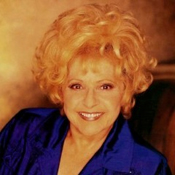Featured Artist: Brenda Lee
 Vintage clips of Brenda Lee singing “Dynamite” in 1957 show her wearing a cute, puffy-shouldered dress with a ribbon tie, yet — when she snarls the title — all traces of a 12-year-old girl evaporate.
Vintage clips of Brenda Lee singing “Dynamite” in 1957 show her wearing a cute, puffy-shouldered dress with a ribbon tie, yet — when she snarls the title — all traces of a 12-year-old girl evaporate.
“I was a rocker,” declares Brenda with a hearty laugh. “And I’m supposedly the first female rocker in what we know as rock ’n’ roll, so I’ll take it!”
Brenda’s mother, Annie Grayce Tarpley, had signed a Decca Records contract for her daughter Brenda Mae on May 21, 1956. Just over two months later, Brenda was standing in front of a team of crack session musicians at Owen Bradley’s recording studio (the legendary “Quonset Hut”) in Nashville. (Even though it was her studio debut, she had already logged many hours as a performer, including on Augusta TV’s “Peach Blossom Special,” where the program director suggested that “Tarpley” be shortened to “Lee.”)
Among the seven songs that Brenda belted out on that date was Hank Williams’ “Jambalaya,” which she’d sung live at Augusta’s Bell Auditorium in February 1956. Her performance there left host Red Foley mesmerized, and when she sang it again for Red on “The Ozark Jubilee” national TV show, the network received 25,000 letters from enthusiastic fans.
Released in September, “Jambalaya (On the Bayou)” — backed with “Bigelow 6-200” — brought Brenda additional bookings on prime-time TV and a gig at Las Vegas’ Flamingo Hotel. She was the youngest headliner ever to perform on The Strip.
However, the extreme excitement that Brenda generated in person didn’t translate into record sales. Apart from modest showings by “One Step at a Time” (her third 45) and “Dynamite” (her fourth), her first 10 singles were ignored, even the original 1958 release of the holiday classic “Rockin’ Around the Christmas Tree.”
Fortunately, her manager, Dub Allbritten — like Brian Epstein when he saw The Beatles in November 1961 — absolutely believed in her: superstardom was simply a matter of when rather than if.
Hearing that French radio was airing her rockabilly records, Dub boldly booked Brenda into the renowned L’Olympia in Paris. He also planted a story in the French press that she was a “32-year-old midget.” On Feb. 18, 1959, the packed-house patrons saw that she was 14 and that her voice was just as brassy on stage as on record. Overnight Brenda became the toast of the City of Light: her stay was extended to five weeks, followed by stops in Belgium, Italy and England.
History repeated itself later that year when Brenda toured Brazil after the three-years-old “Jambalaya” became a big hit.
Back home, her recording career finally kicked into gear with “Sweet Nothin’s” — a decidedly different disc for Brenda. After some whispered introductory gibberish by Louis Nunley of the Anita Kerr Singers, Brenda — who didn’t even date — launched into a growling, sassy vocal worthy of a come-hither vamp who knows what she wants and how to get it.
“Now when I listen back, [I realize] it was sexy,” says Brenda. “People say, ‘How’d you do that?’ I don’t know. I just sang them the way that I felt like they needed to be sung. It was just a God-given thing.”
A month shy of four years since Brenda had signed with Decca, “Little Miss Dynamite” delivered her first of 29 Top 40 pop hits when “Sweet Nothin’s” reached No. 4 on Billboard magazine’s Hot 100 pop chart, and No. 3 in “Cash Box” and “Record World.”
“Sweet Nothin’s” had barely cooled off before Brenda’s next single began its climb. The intended A-side, “That’s All You Gotta Do,” was penned by a future star looking for his first success. “I met Jerry Reed on the tarmac, [when I was] changing planes in Atlanta,” says Brenda. “He was coming home from the service. He handed me a demo right there and said, ‘I’ve written this song and I think it’s perfect for you. Would you listen to it?’ I did and I cut it and we were buds from then on.” “All You Gotta Do” became a 1960 summertime No. 6 smash; the flip side did even better.
Brenda had been “dying to record” “I’m Sorry” for several years and she finally got her chance at the tail end of a session. Like all of her studio dates, says Brenda, “it was a group effort. It was Owen, it was me, it was all the A-team musicians, it was the Anita Kerr Singers. [Everybody] had a say, all those wonderful, magical people, and that’s the way I wanted it.”
Brenda’s “say” on “I’m Sorry” included the spoken section, inspired by the recitations of The Ink Spots, and the slow, hiccupping vocal effect. The whole process took just 15 minutes, two takes. “I always did better if my [singing] was spontaneous. If I rehearsed it and rehearsed it, it didn’t come off good.”
The Decca label execs were reluctant to release such an adult ballad by Brenda, but her belief in the song’s power was dead on: “I’m Sorry” went all the way to No. 1.
Her next release was also a mature ballad. Brenda had fallen in love with the melody of an Italian song called “Per Tutta La Vita” for which veteran composer James “Kim” Gannon wrote English lyrics. “‘I Want to Be Wanted,’” Brenda says, “was such a beautiful song. I didn’t have a boyfriend and I had not experienced any sort of relationship whatsoever. It was just that the song was so beautiful, and if the lyrics are great, I can sing them.”
And sing it she did. “I Want to Be Wanted” became Brenda’s second chart-topping single.
“Wanted” marked two notable trends in Brenda’s career. It was her second Hot 100 double-sided hit out of 15 total — tops for a female solo singer. Plus, it was the first of several international songs that she recorded. “‘All Alone Am I’ and ‘Losing You,’” says Brenda, “were also foreign songs. I used to get a lot of foreign material because I traveled internationally so much and I was very popular [there].”
It was during one of those overseas jaunts that Brenda crossed paths with The Beatles at Hamburg’s infamous Star-Club. Paul McCartney and John Lennon, in particular, were big fans. Paul had seen her Liverpool concert in April 1961 and later took the lead on “Fool #1” in the Fab Four’s live set, while John stated unequivocally that Brenda had “the greatest rock ’n’ roll voice of them all.”
In September 1964, Brenda did a London session, with Mickie Most (The Animals, Herman’s Hermits, The Yardbirds) producing and a 20-year-old Jimmy Page playing lead guitar. The result — “Is It True” — was a fine slice of U.K.-meets-U.S. rock ’n’ roll, which showed that Brenda could hold her own with the best of the hottest British Invasion artists.
Still, the times were indeed a-changin’, and when Brenda logged her final Cash Box and Record World Top 40 side with “Johnny One Time” in 1969, her reign as rock’s dynamite female was over. As she said in her autobiography, “I didn’t know if there was a place for me in the recording business anymore. I had the blues and I had ‘em bad.”
Just when Brenda needed a “white knight,” one appeared in the guise of Kris Kristofferson, who knew of her struggles and thought he had just what she needed: a tune called “Nobody Wins.” After a 12-year drought on the country charts (1957-1969), its chance of success there, even when sung by Brenda, was far from certain. “I was much more popular in the North,” she says, “[even though] I was a Southerner, true blue and bred.”
That was due, in part, to her manager. “Dub’s vision for me was worldwide,” she says, “and not [to] be pigeonholed in any one form of music, and certainly, at that time, not country. Because [early in my career], country, as great as it was, was not the masses. And he wanted me to be able to do it all and to be accepted in it all [and] I was.”
“Nobody,” though, won the hearts of her fellow Southerners, peaking at No. 5 in early 1973. Says Brenda, “We recorded the way we always had. We chose the best songs that were available to us and the ones that I could do the best. Music changed; I didn’t.”
It sure did: Brenda reeled off six straight Top 10 country hits and ultimately placed 34 sides on that list. In 1997 she was elected into the Country Music Hall of Fame.
Induction into the Rockabilly Hall of Fame followed in 1999, and, with her entry into the Rock and Roll Hall of Fame in 2002, Brenda became the only woman selected to both the Country and Rock halls.
Reflecting on her 60 years in music and her many accomplishments, Brenda says, “I never sat around and thought, ‘Oh, I’ll be number one or I’ll make this much money.’ I just always wanted to sing, and I knew I would, somewhere. I never dreamed that it would be on the scale that it has been, and I’m absolutely grateful for that. I was always true to myself with my material and my presentation, and I was honest and good to my fans and the DJs. I didn’t do this all by myself.”
Asked about what she’s most proud of in her life, Brenda replies, “That I have genuinely tried to be as good and giving and helpful as I can to everybody in any walk of life. Of course, I’m so proud to be a mother and grandmother, and to have been married for almost 52 years.”
As for the 2014 Malt Shop Memories Cruise, she’s “looking forward to seeing the fans and being involved with them on a one-to-one basis. My fans are my friends: They are part of what and who I am, and I love them dearly. [Plus] I do a rockin’ show and I’m in constant motion and I love it. We’ll have a good time!”
— Ed Osborne © 2014
